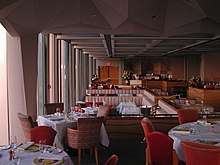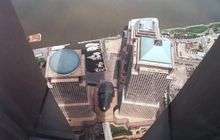Windows on the World
Windows on the World was a complex of venues on the top floors (106th and 107th) of the North Tower (Building One) of the original World Trade Center complex in Lower Manhattan. It included a restaurant called Windows on the World, a smaller restaurant called Wild Blue, a bar called The Greatest Bar on Earth, and rooms for private functions. Developed by restaurateur Joe Baum and designed initially by Warren Platner, Windows on the World occupied 50,000 square feet (4,600 m²) of space in the North Tower. The restaurants opened on April 19, 1976, and were destroyed in the September 11, 2001, attacks.[1]
| Windows on the World | |
|---|---|
 | |
| Restaurant information | |
| Established | April 19, 1976 |
| Closed | September 11, 2001 (destroyed in September 11 attacks) |
| Previous owner(s) | David Emil |
| Head chef | Michael Lomonaco |
| Street address | 1 World Trade Center, 107th Floor, Manhattan, New York City, NY, U.S. |
| City | New York City, New York |
| Postal/ZIP Code | 10048 |
| Country | United States of America |
| Seating capacity | 240 |
| Website | windowsontheworld.com |
Operations


The main dining room faced north and east, allowing guests to look out onto the skyline of Manhattan. The dress code required jackets for men and was strictly enforced; a man who arrived with a reservation but without a jacket was seated at the bar. The restaurant offered jackets that were loaned to the patrons so they could eat in the main dining room.[2]
A more intimate dining room, Wild Blue, was located on the south side of the restaurant. The bar extended along the south side of 1 World Trade Center as well as the corner over part of the east side. Looking out from the bar through the full length windows, one could see views of the southern tip of Manhattan, where the Hudson and East Rivers meet. In addition, one could see the Liberty State Park with Ellis Island and Staten Island with the Verrazano-Narrows Bridge. The kitchens, utility and conference spaces for the restaurant were located on the 106th floor.
Windows on the World closed after the 1993 bombing, in which employee Wilfredo Mercado was killed while checking in deliveries in the building's underground garage. It underwent a US$25 million renovation and reopened in 1996.[3][4] In 2000, its final full year of operation, it reported revenues of US$37 million, making it the highest-grossing restaurant in the United States.[5]
The executive chefs of Windows on the World included Philippe Feret of Brasserie Julien; the last chef was Michael Lomonaco.
September 11 attacks
Windows on the World was destroyed when the North Tower collapsed during the terrorist attacks of September 11, 2001. That morning, the restaurant was hosting regular breakfast patrons and the Risk Waters Financial Technology Congress.[6] World Trade Center lessor Larry Silverstein was regularly holding breakfast meetings in Windows on the World with tenants as part of his recent acquisition of the Twin Towers from the Port Authority, and was scheduled to be in the restaurant on the morning of the attacks. However, his wife insisted he go to a dermatologist's appointment that morning,[7] whereby he avoided death. Everyone present in the restaurant when American Airlines Flight 11 penetrated the North Tower perished that day, as all means of escape and evacuation (including the stairwells and elevators leading to below the impact zone) were instantly cut off. Victims trapped in Windows on the World died either from smoke inhalation from the fire, jumping or falling from the building to their deaths, or the eventual collapse of the North Tower 102 minutes later.
There were 72 restaurant staff present in the restaurant, including acting manager Christine Anne Olender, whose desperate calls to Port Authority police represented the restaurant's final communications.[8] 16 Incisive Media-Risk Waters Group employees, and 76 other guests/contractors were also present.[9] After about 9:40 AM, no further distress calls from the restaurant were made. The last people to leave the restaurant before Flight 11 collided with the North Tower at 8:46 AM were Michael Nestor, Liz Thompson, Geoffrey Wharton, and Richard Tierney. They departed at 8:44 AM and survived the attack.[10]
Critical review
In its last iteration, Windows on the World received mixed reviews. Ruth Reichl, a New York Times food critic, said in December 1996 that "nobody will ever go to Windows on the World just to eat, but even the fussiest food person can now be content dining at one of New York's favorite tourist destinations." She gave the restaurant two out of four stars, signifying a "very good" quality rather than "excellent" (three stars) or "extraordinary" (four stars).[11] In his 2009 book Appetite, William Grimes wrote that "At Windows, New York was the main course."[12] In 2014, Ryan Sutton of Eater.com compared the now-destroyed restaurant's cuisine to that of its replacement, One World Observatory. He stated, "Windows helped usher in a new era of captive audience dining in that the restaurant was a destination in itself, rather than a lazy byproduct of the vital institution it resided in."[13]
Cultural impact and legacy
Windows of Hope Family Relief Fund was organized soon after the attacks to provide support and services to the families of those in the food, beverage, and hospitality industries who had been killed on September 11 in the World Trade Center. Windows on the World executive chef Michael Lomonaco and owner-operator David Emil were among the founders of that fund.
It has been speculated that The Falling Man, a famous photograph of a man dressed in white falling headfirst on September 11, was an employee at Windows on the World. Although his identity has never been conclusively established, he was believed to be Jonathan Briley, an audio technician at the restaurant.[14]
On March 30, 2005, the novel Windows on the World, by Frédéric Beigbeder, was released. The novel focuses on two brothers, aged 7 and 9 years, who are in the restaurant with their dad Carthew Yorsten. The novel starts at 8:29 AM (just before the plane hits the tower) and tells about every event on every following minute, ending at 10:30 AM, just after the collapse. Published in 2012, Kenneth Womack's novel The Restaurant at the End of the World offers a fictive recreation of the lives of the staff and visitors at the Windows on the World complex on the morning of September 11.
On January 4, 2006, a number of former Windows on the World staff opened Colors, a co-operative restaurant in Manhattan that serves as a tribute to their colleagues and whose menu reflects the diversity of the former Windows' staff. That original restaurant closed, but its founders' umbrella organization, Restaurant Opportunities Centers United, continues its mission, including at Colors restaurants in New York and other cities.
Windows on the World was planned to reopen on the top floors of the new One World Trade Center, when the tower completed; however, on March 7, 2011, it was cancelled because of cost concerns and other troubles finding support for the project.[15] But successors of Windows on the World, One Dine, One Mix and One Cafe, are located at One World Observatory.[16]
See also
- List of tenants in One World Trade Center
- Top of the World Trade Center Observatories
References
- "Trade Center to Let Public In for Lunch At Roof Restaurant". New York Times. April 16, 1976. Retrieved October 15, 2009.
- Chong, Ping. The East/West Quartet. p. 143.
- "New Windows on a New World;Can the Food Ever Match the View?". The New York Times. June 19, 1996. Retrieved May 18, 2018.
- "Windows That Rose So Close To the Sun". The New York Times. September 19, 2001. Retrieved May 18, 2018.
- The Wine News Magazine Archived 2012-02-20 at the Wayback Machine
- "Risk Waters Group World Trade Center Appeal".
- "Larry Silverstein: Silverstein Properties". New York Observer. Archived from the original on October 2, 2013. Retrieved April 2, 2013.
- "'We need to find a safe haven,' WTC restaurant manager pleads". USA Today. August 28, 2003. Archived from the original on October 23, 2012. Retrieved June 26, 2014.
- "Risk Waters Group archived home page". Archived from the original on August 2, 2002.
- "9/11: Distant voices, still lives (part one)". The Guardian. London. August 18, 2002. Retrieved September 17, 2015.
- Reichl, Ruth (December 31, 1997). "Restaurants; Food That's Nearly Worthy of the View". The New York Times. ISSN 0362-4331. Retrieved February 22, 2018.
- Grimes, William (October 13, 2009). Appetite City: A Culinary History of New York. Farrar, Straus and Giroux. p. 281. ISBN 978-1-42999-027-1.
- Sutton, Ryan (June 30, 2015). "Everything You Need to Know About Dining at One World Trade". Eater NY. Retrieved February 22, 2018.
- Henry Singer (director) (2006). 9/11: The Falling Man (Documentary). Channel 4.
- Feiden, Douglas (March 7, 2011). "Plans to build new version of Windows on the World at top of Freedom Tower are scrapped". Daily News. New York.
- "One Dine". One World Observatory.
External links
| Wikimedia Commons has media related to Windows on the World. |